The Goat Village - 6 Reasons to Go Back
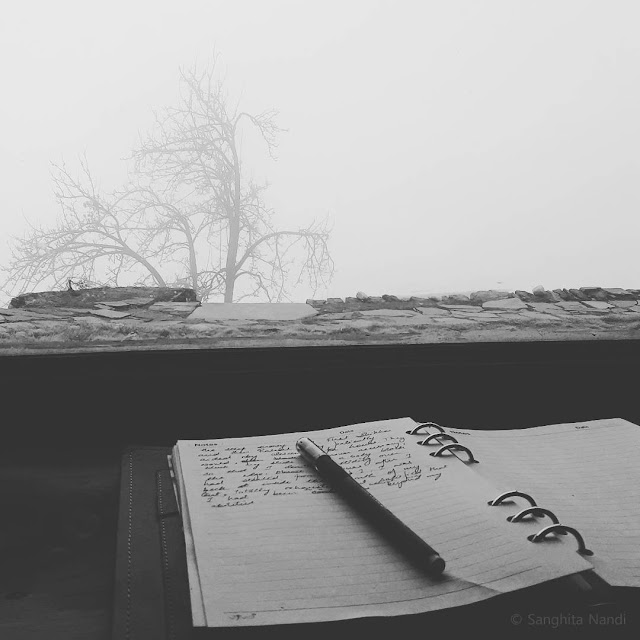
"Shrouding everything except that lone tree that stood like a sentry near my cottage, the clouds flow in faster than I have ever seen. Somewhere a Himalayan bird chirps and a thunder rumbles, which sounds like a violent wave crashing on the shore. I take a moment off scribbling my thoughts and sigh at my heavenly abode."
Without my laptop, I had resorted back to holding a pen. Without any mobile connectivity, I had started to have meaningful conversations with real people. And without the presence of any artificial light after sunset, I was finally forced to get rid of the fear of darkness that had haunted me for ages. Up in the mountain, halfway to Nag Tibba, lies 'The Goat Village', a network-forsaken place with no electricity and worldly comforts where I had finally started to feel at home.
At first look, it may look like a cluster of mountain cottages. Indeed The Goat Village is a rustic farm stay - a pioneer agritourism initiative of India - where you can spend your days in bliss. But there is a twist in the tale.
A GOOD CAUSE
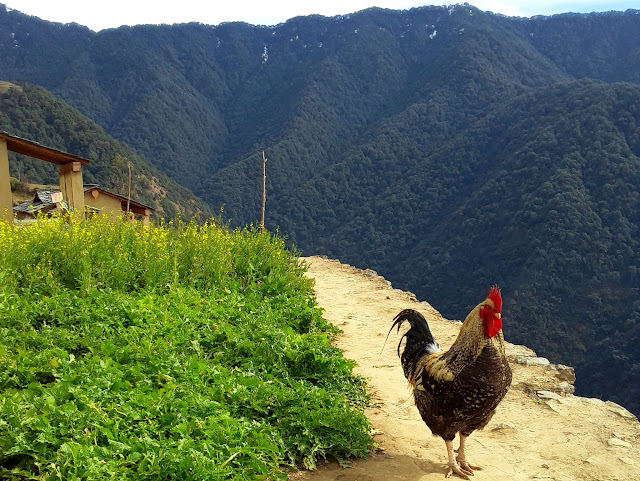
The Goat Village or TGV, the brainchild of a socio-commercial organization called The Green People, is not a resort or any such typical tourist accommodation. They are exactly what they call themselves – a village that was created to re-establish ancient Indian village hospitality, to encourage locals to re-adapt their own indigenous and natural ways of living, to enliven abandoned and forsaken lands of the middle & lower Himalayas. In a time when the local mountain folks are heading to the cities leaving behind their agricultural roots, The Green People aims to bring about a wave of reverse migration by creating success stories among the locals.
On my day of arrival, it was already late afternoon by the time I had reached Laser Gaon, the last point till where you can drive to reach TGV. As I began the 1.9 km trek with two TGV staff, the sun started its plunge towards the horizon.
THE SUNSET

The twilight sky soon turned a shade of purple merged with a fiery orange, as the dipping sun looked like molten gold. Nature had turned into an artist, whose brushstrokes I couldn’t help but stop and admire. I have seen many beautiful sunsets around the world but standing there, seeing the sky change color like it did, took my breath away and made me crave for more. I sighed and trekked forward with no idea that my wish was about to come true, that I was going to be rewarded with many such sunsets during my stay.

When I finally arrived at TGV after a climb of almost two hours, the entire village was shrouded in darkness. The lack of electricity did not stop them from giving me a very warm welcome in the lights of candles. It felt like the Danish concept of Hygge.
After a glass of refreshing cinnamon tea and 'harabhara kebabs' made from homegrown spinach, Mani, the 'village manager, led me to my cottage with the help of a solar torch.
THE COTTAGES
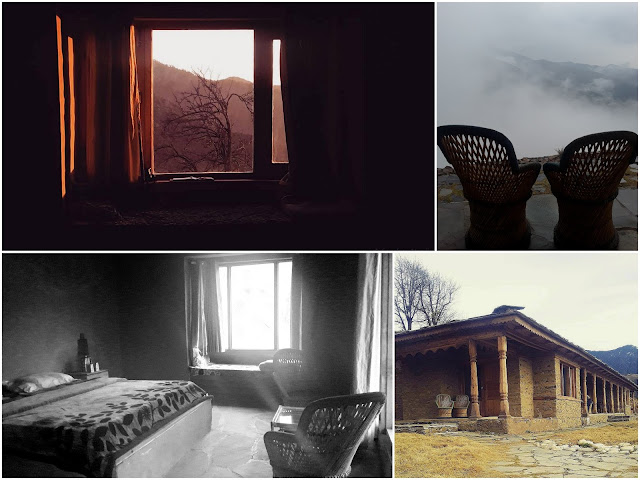
I did not have to wait till morning to fall in love with the cottage, which as Mani narrated, is a Koti Banal architecture.
Dating back almost 1000 years, Koti Banal was an earthquake-proof way of building the local homes in Uttarakhand. These ornate houses were often multi-storeyed, with abundant use of wooden beams, stones, slates, mud, and cow dung. But with changing times, as the locals started opting for modern cement houses, the workers skilled in constructing Koti Banal houses were left jobless and with crushed self-esteem. It was another feat achieved by the Green People when they finally revived this forgotten skill in the local workers by employing them during the construction of The Goat Village cottages.
In the light of candles and solar light, I noticed that my spacious cottage had a high ceiling made of wooden beams. With mud walls and minimalist decoration, my room was complete with a comfortable king-size bed, a mirror, a bedside table, and a couple of cane chairs. There was no television, mark it, and along with zero-network, it was a golden opportunity to cut distractions and be present in the moment. My favorite place in the room - in the upcoming days - turned out to be the lounge bed next to the wide window overlooking the blue mountains.
As the first night passed and the morning light filled my room, I heard a gentle knock on my door, something I would soon get used to.
FOOD AND DRINKS
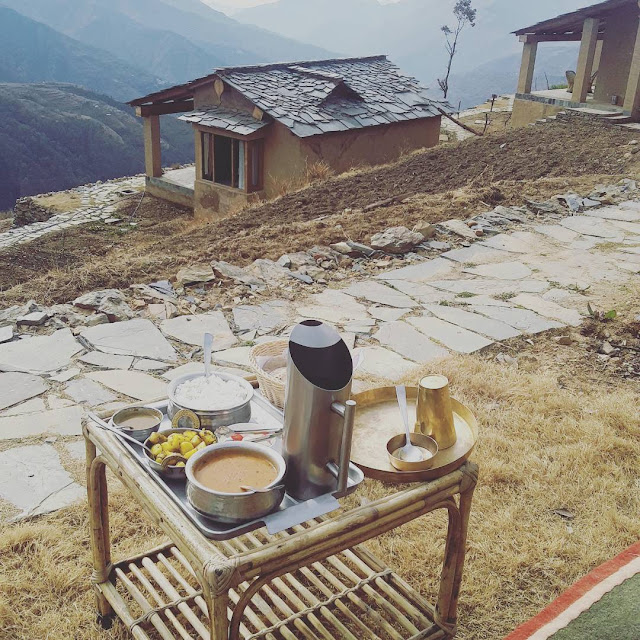
My days at TGV usually started with that knock on the door. Suraj, one of the staff would diligently bring me a refreshing bed tea - sometimes made of chamomile, sometimes cinnamon, and sometimes mint – to wake me up in style. The food served throughout the day would be healthy and organic, like barnyard millet porridge, finger millet sandwiches, horse gram daal with Himalayan red rice, or roti made of wheat, barley, or corn. Most of these products are home-grown and sold under the brand of ‘Bakri Chhap’ for the upliftment of the locals working towards growing and packaging these products.
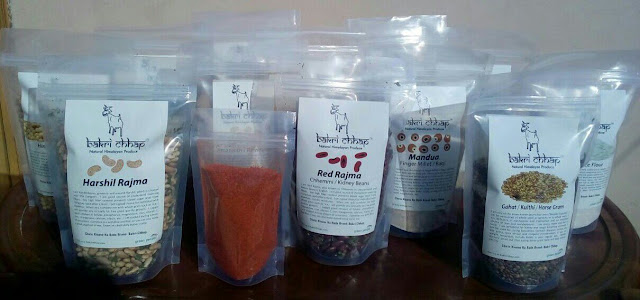
At times, there would even be delicious farm eggs or a chicken curry to satisfy the need of a non-vegetarian like me. Sometimes after a walk in the nearby villages, we would come back to a soothing glass of Rhododendron juice which, for the record, tasted far better than juices with preservatives or any aerated cold drinks. My dreams of losing weight burnt in hell as the kitchen staff started surprising me with a different menu every day. For such a mouth-watering Garhwali cuisine, the foodie in me drools to go back as soon as I can.
But if I had to choose only one reason to head back to The Goat Village, it would be for their cafeteria, a place I fell head over heels in love with.
THE CAFETERIA
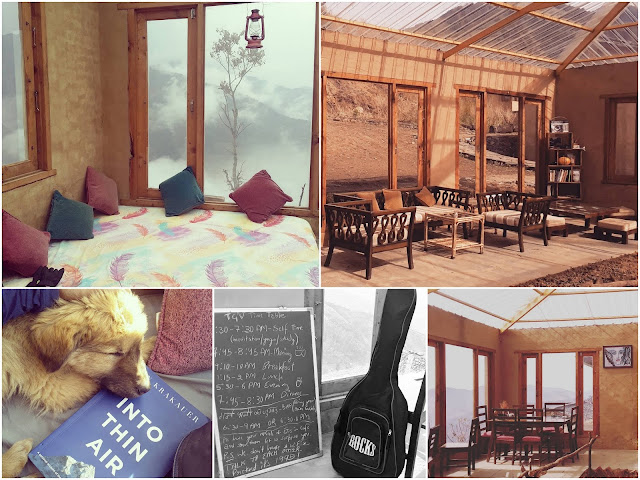
Its many windows and the transparent ceiling let light stream in during the day, and more beautifully on a moonlit night. I spent most of my days there, writing, reading books that they have stacked up in a corner, or just playing with Jhilmil and Rimjhim, the cuddly puppies adopted by TGV. You may even play the guitar, or just enjoy a generous dose of La Dolce Far Niente, the sweetness of doing nothing. It is the perfect place to unwind, soak up some Vitamin D, forget about your busy city life, and for the moment – just live in sheer bliss.
It was while sitting in the cafeteria one night when Mani mentioned ‘Bakri Swayamvar’ to me.
***
When Mani first started talking about the Bakri Swayamvar, it sounded like a prank. The Green People were planning to get goats married in the mythological Swayamvar style, where the female goat would have the privilege to choose her ‘groom’ or mate from a number of male goats. As I started laughing, he started explaining. It was not by chance that The Goat Village was so named.
Goats, the oldest domesticated animals in human civilization, have been an integral part of the livelihood of the locals of Uttarakhand. They represent the most indigenous and ancient ways of survival and of making a living in the Indian Himalayas. In the words of Mani, “Goat rearing in some villages of Uttarakhand still burns the fuel in the houses of the poorest family. Goats are our friends, the spirit of these mountain villages. Goats are our mascot and our hope to evolve into a community of some happy and evolved goat herders who take pride in going back to their roots.”
However, with time, goat rearing is no more considered to be a lucrative occupation and thus there has been a lot of inefficient in-breeding within the local herds. About to be held on 24th February 2017, the Bakri Swayamvar aims to initiate scientific and selective breeding of the Himalayan goats for their gene pool improvement. Healthier goats would mean healthy offspring, better lactation, and optimum use of goat milk, which has tons of health benefits.
***
My days at The Goat Village, Nag Tibba came to an end when I got an unexpected offer to accompany Mani and the TGV audit team to another of their property at Raithal. It is a story of another time about how I hopped onto the back of a mini-truck with these happy-go-lucky people and drove away to Uttarkashi, to higher mountains, and to an entirely women-managed farm stay.
For now, after a week in the chaotic Capital city, I am heading back to The Goat Village for the humongous and hilarious event called Bakri Swayamvar, which I can't wait to be a part of.
You are invited too. Here's how To Reach:
There are many trains and buses that ply between Delhi and Dehradun. From Dehradun, Pantwari is 3 hours by car. The pocket-friendly way is to come by the share taxis that leave twice a day from Dehradun at 7 A.M. and 12 P.M. and from Pantwari, you can book one of the local taxis to drop you till Laser Gaon. The path from there is well-marked for the next 1.9 km.
You can 'Pay What You Like' during your stay at The Goat Village.

0 Comments Add a Comment?